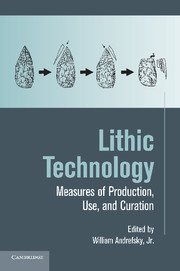Book contents
- Frontmatter
- Contents
- Preface and Acknowledgments
- List of Contributors
- PART I INTRODUCTION, BACKGROUND, AND REVIEW
- PART II PRODUCTION, REDUCTION, AND RETOUCH
- PART III NEW PERSPECTIVES ON LITHIC RAW MATERIAL AND TECHNOLOGY
- 9 Projectile Point Provisioning Strategies and Human Land Use
- 10 The Role of Lithic Raw Material Availability and Quality in Determining Tool Kit Size, Tool Function, and Degree of Retouch: A Case Study from Skink Rockshelter (46NI445), West Virginia
- 11 Raw Material and Retouched Flakes
- PART IV EVOLUTIONARY APPROACHES TO LITHIC TECHNOLOGIES
- Index
- References
11 - Raw Material and Retouched Flakes
Published online by Cambridge University Press: 22 August 2009
- Frontmatter
- Contents
- Preface and Acknowledgments
- List of Contributors
- PART I INTRODUCTION, BACKGROUND, AND REVIEW
- PART II PRODUCTION, REDUCTION, AND RETOUCH
- PART III NEW PERSPECTIVES ON LITHIC RAW MATERIAL AND TECHNOLOGY
- 9 Projectile Point Provisioning Strategies and Human Land Use
- 10 The Role of Lithic Raw Material Availability and Quality in Determining Tool Kit Size, Tool Function, and Degree of Retouch: A Case Study from Skink Rockshelter (46NI445), West Virginia
- 11 Raw Material and Retouched Flakes
- PART IV EVOLUTIONARY APPROACHES TO LITHIC TECHNOLOGIES
- Index
- References
Summary
Abstract
Lithic analysts are often criticized for not engaging in theory building and for conducting particularistic studies. Such particularistic studies can be linked to theory through an organization-of-technology approach, which has great promise. However, concepts often employed in the approach, such as curation, need further refinement to become operationalized. One way to accomplish this for flake tools is to develop a method for measuring the amount of tool resharpening. One method is to determine the original flake mass and compare this to the mass of the recovered tool to determine the amount of realized use life. Here, a series of experiments in producing retouched flakes using various raw materials and two reduction modes were conducted by two flintknappers to determine how these variables influence the prediction of flake mass. Analysis indicates that raw material type is important for estimating original flake mass, but a tripartite division of quality may be sufficient to account for the variation. No significant differences are evident between the two knappers. Equations used to calculate original flake mass from retouched flakes must be derived with a consideration of raw material.
INTRODUCTION
A decade ago, George Odell discussed the “particularism” that was apparent in lithic studies and the need to link these studies to theory and to prehistoric behavior (Odell 1996a: 2–3). This is something of an echo of the characterization of lithic analysis made by David Hurst Thomas a decade prior as “in danger of chasing rainbows rather than providing archaeology with the theory so obviously lacking” (Thomas 1986: 247).
- Type
- Chapter
- Information
- Lithic TechnologyMeasures of Production, Use and Curation, pp. 233 - 254Publisher: Cambridge University PressPrint publication year: 2008
References
- 6
- Cited by

